Whenever I visit one of these archaeological sites, I try to imagine what life must have been like at the height of the city’s power.
Where did the people live? How did they live? Where did they go to buy (or barter for) their food and supplies and what did they do to pass the time?
At some sites, where you’ve got little more than a pile of rocks to stir the imagination, this is easier said than done but not at Cantona. Here, it really is easy. I’ve been to a few of these Mexican ruins and Cantona is by far the most interesting and well-preserved.
If you’re visiting Puebla and have a keen interest in archaeology, then you should set a day aside for Cantona. It’ll give you a glimpse of life in ancient Mexico like no other archaeological site in the country.
VISIT PUEBLA QUICK LINKS
TOURS
To help you make the most of your time in Puebla, we’ve compiled links to recommended tours and activities here. Click on the link for a guide to some of the best Puebla Tours.
- Cantona Tours: Day Tours to Cantona
- Puebla Tours: Puebla Sightseeing and Food Tours
- Day Trips: Day Trips to Puebla from Mexico City
- Cooking Classes: Puebla Cooking Classes
HOTELS
Recommended hotels in the Historic Center, the most convenient area to stay for first-time visitors to Puebla. Click on the link for more Puebla hotel recommendations.
- Luxury: Casona de los Sapos Hotel Boutique
- Midrange: Hotel Boutique Casareyna
- Budget: Hostal Casa De Arcos
OTHER SERVICES
Save This on Pinterest!
No time to read this article on the Cantona archaeological ruins in Puebla? Click on the save button and pin it for later!

CANTONA ARCHAEOLOGICAL RUINS AT A GLANCE
- Cantona is located in Tepeyahualco, about 62 miles (100 km) northeast of downtown Puebla.
- The site covers an area of around 4.6 sq miles (12 sq km). It features a road network of over 500 cobblestone walkways, more than 3,000 separate residences, 24 ball courts, and an elaborate acropolis.
- The ancient city is estimated to have been built around 50 CE. It reached the height of its power around 600-1000 CE and had a population of around 80,000 people. It was abandoned after 1050 CE.
- Cantona is considered the largest urban center that’s been discovered in Mesoamerica.
- The name “Cantona” is derived from the Nahuatl Caltonal, meaning “House of the Sun”.
WHAT ARE THE CANTONA ARCHAEOLOGICAL RUINS?
Cantona is a Mesoamerican archaeological site that’s believed to be one of the largest and most urbanized cities in pre-Columbian Mexico.
It’s a remarkably well-preserved site that covers an area of around 4.6 square miles (12 sq km). Divided into three urban areas, it features a road network of over 500 cobblestone walkways, over 3,000 individual residences, 24 ball courts, and an acropolis. Remarkably, the structures at Cantona were built without the use of any mortar or cement.
This ancient Mesoamerican city is estimated to have been built around 50 CE. It isn’t entirely clear who its first settlers were, but it’s believed to have been founded by the Olmeca-Xicallanca people.
Cantona reached the height of its powers from around 600 to 1000 CE. At its peak, it had a population of over 80,000 people, most of whom were agricultural farmers or traders. Much of the city’s prosperity can be attributed to the trade of obsidian which was extracted from the Oyameles-Zaragoza mountains surrounding the city.
For unknown reasons, Cantona was abandoned in 1050 before being rediscovered by Swiss mineralogist Henri de Saussure in 1855. Its name is derived from the Nahuatl word Caltonal, meaning “House of the Sun”.
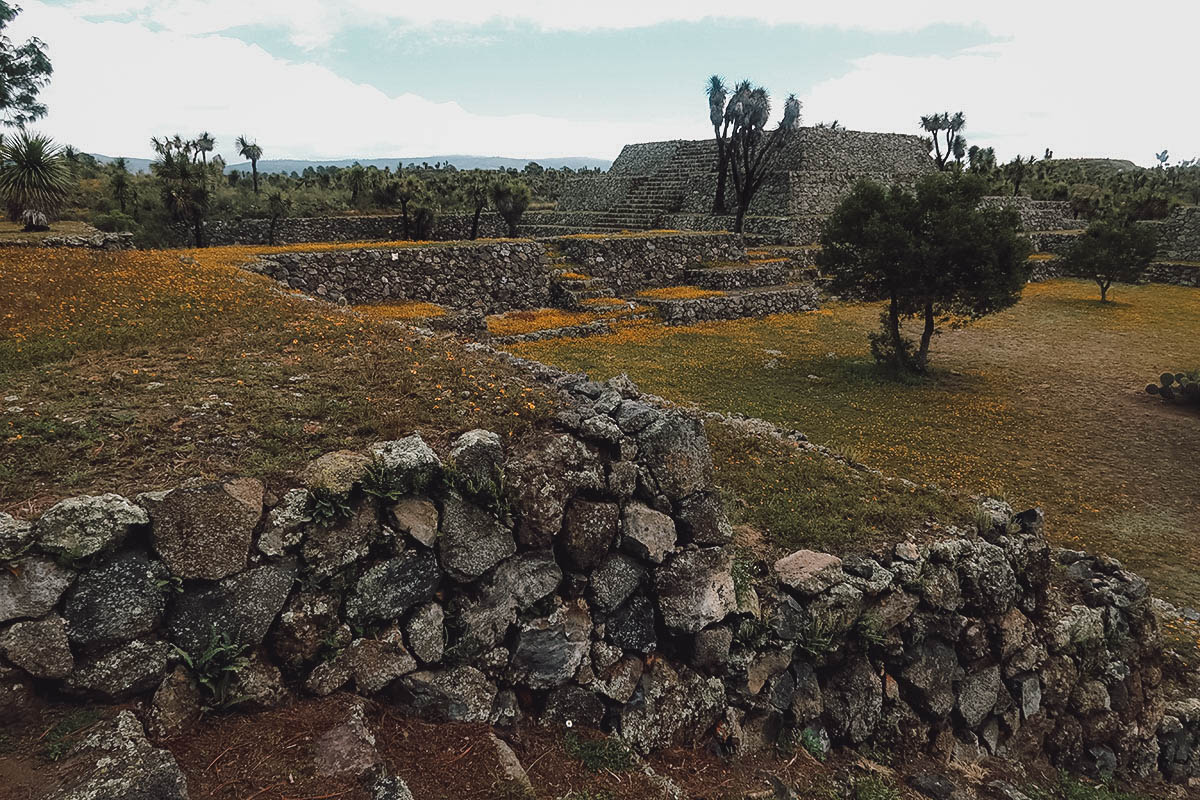
HOW TO GET TO CANTONA
Cantona is located in Tepeyahualco, about 62 miles (100 km) northeast of downtown Puebla. It’s situated in the northeastern part of Puebla state, close to the border with Veracruz.
The ruins are in a remote area that’s difficult to get to using public transportation. According to my guide, he isn’t aware of any public buses that can take you there so it’s best to go by guided tour, private car, or taxi.
By Guided Tour
This is the easiest way to visit Cantona from Puebla. Booking a tour takes care of roundtrip transportation, plus you’ll have a guide to explain the history of the ruins to you. I often visit tourist destinations on my own but historic attractions like Cantona are best explored with a knowledgeable guide.
I went on this private Cantona tour with Get Your Guide. It includes pickup (and dropoff) from your hotel in downtown Puebla or Cholula.
By Self-Drive
Going with a knowledgeable guide makes for the most fulfilling experience but driving to Cantona on your own will give you the most freedom. You can spend as much time as you’d like at the site and make as many stops along the way.
If you don’t have your own car, then you can rent one through rentalcars.com. The trip should take you around 1.5 hours from Puebla City and over 3 hours from Mexico City. Aside from car insurance, it may be a good idea to get travel insurance as well.
By Taxi / Uber
I read that you can take a taxi to Cantona from Puebla for around MXN 500 each way but this may not be accurate in 2022 and beyond. I just did a dummy booking on Uber and the app quoted me a one-way fare of MXN 1,600. I’m guessing a taxi will cost even more.
This may be a viable option if you have enough people in your group but it may be hard to find a taxi or Uber driver willing to take you all the way to Cantona (and back). Plus, I’m wary of taxis in Mexico. You can read this article about an express kidnapping incident in Puebla.
For those reasons, I suggest going by guided tour or private car instead.

Cantona Archaeological Zone
Address: Zona Arqueológica de Cantona, 73992 Tepeyahualco, Puebla
Operating Hours: 10AM-5PM, Tue-Sat (closed Sun-Mon)
Entrance Fee: MXN 85
CANTONA ARCHAEOLOGICAL SITE
As described, Cantona is a well-preserved site with an intact road network featuring over 500 of these cobblestone pathways. The main roadway – called “First Avenue” – measures around 1,850 feet (563 meters) in length and takes you into the heart of the city.
As remarkably preserved as these pathways are, many parts are uneven so it’s best to wear comfortable shoes and walk slowly. It’s a large site that offers little cover so it’s a good idea to wear a hat (and/or sunscreen) and bring a bottle of water.

At more famous archaeological sites like Teotihuacán or Chichen Itza, the main structures and pyramids are well-preserved but less attention seems to be given to the residential parts of the city. At Cantona, that isn’t the case.
You’ll see it more clearly in subsequent pictures but these stone platforms served as the bases for houses and buildings.

Can you see those steps between the terraces? They take you up to that top platform that probably served as the base for a small house or shed.

Unless I’m mistaken, this is still part of the “First Avenue”.

This picture gives you a better sense of where the actual houses and buildings fit into the landscape. That stone platform served as the base for someone’s home.
Houses were built from wood and straw so they quickly deteriorated over time, but there’s a reproduction of a typical Mesoamerican house at the Cantona Museum. Located by the entrance, I suggest going there first before you explore the ruins.

According to my guide, these residential ruins spoke volumes about a person’s status. The number of terraced stone platforms was an indicator of wealth. Also, houses that were situated closer to the acropolis likely belonged to the wealthier and more important people of the city.
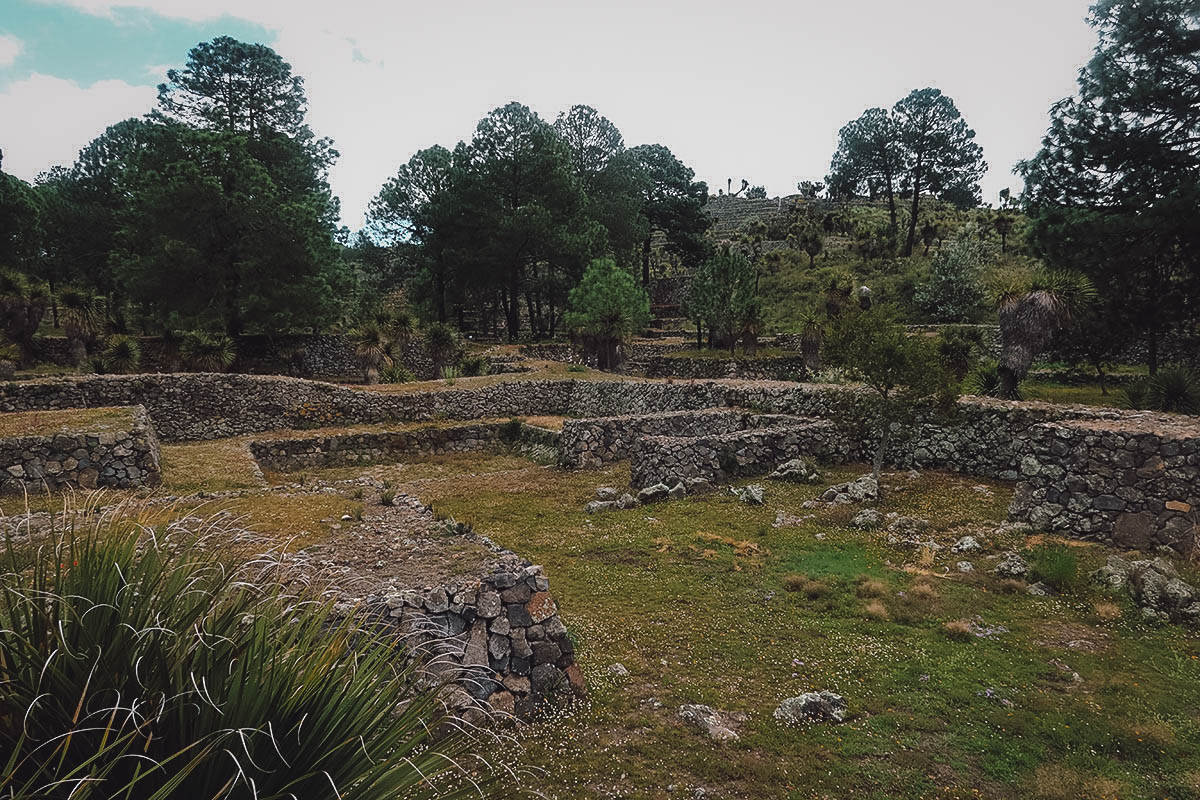
Teotihuacán’s Pyramid of the Sun and Chichen Itza’s EL Castillo are impressive but I find residential ruins like this to be more provocative. They paint a more intimate picture of what life was like in this ancient city.
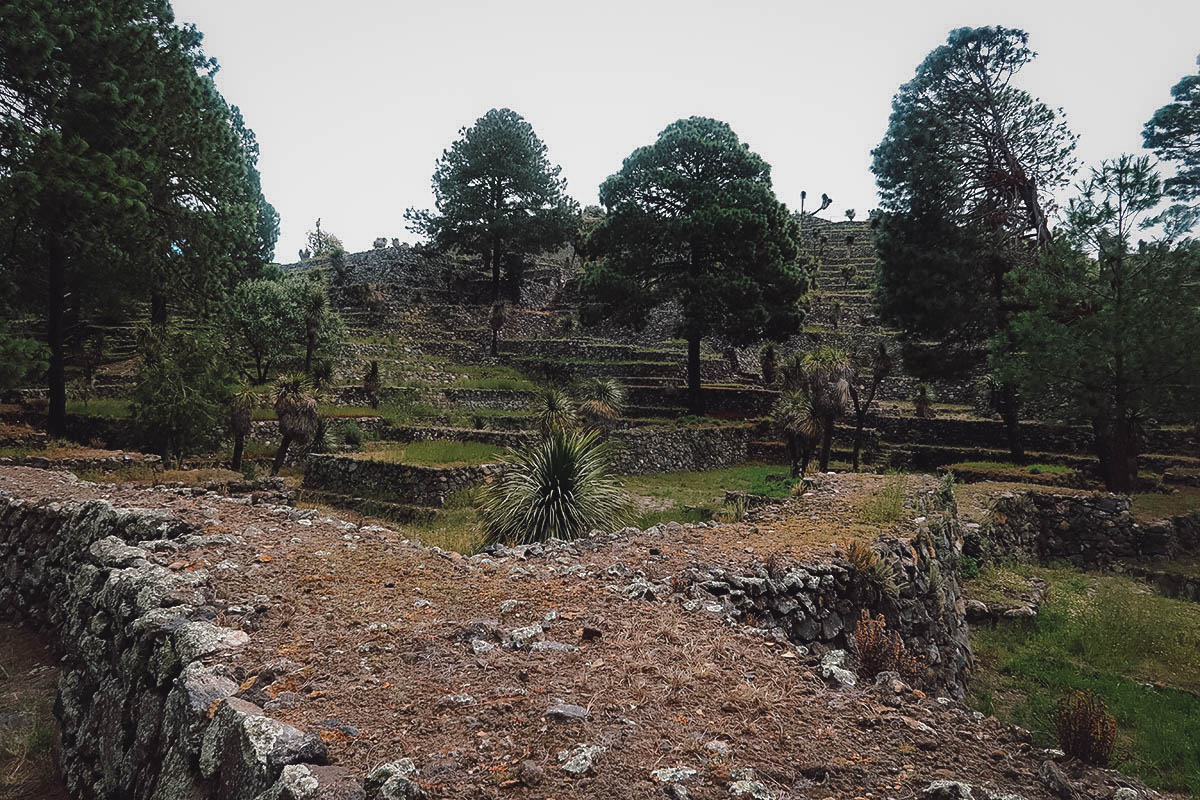
Aside from residential units, pyramids, and walkways, you’ll also find plenty of sacrificial altars at Cantona. Human sacrifices were common at the time and according to my guide, it was a way of life for the local people.
Children were taught at an early age by their parents and grandparents that death was a natural part of the life cycle. Anyone, regardless of status or age, could be sacrificed as an offering to the gods.
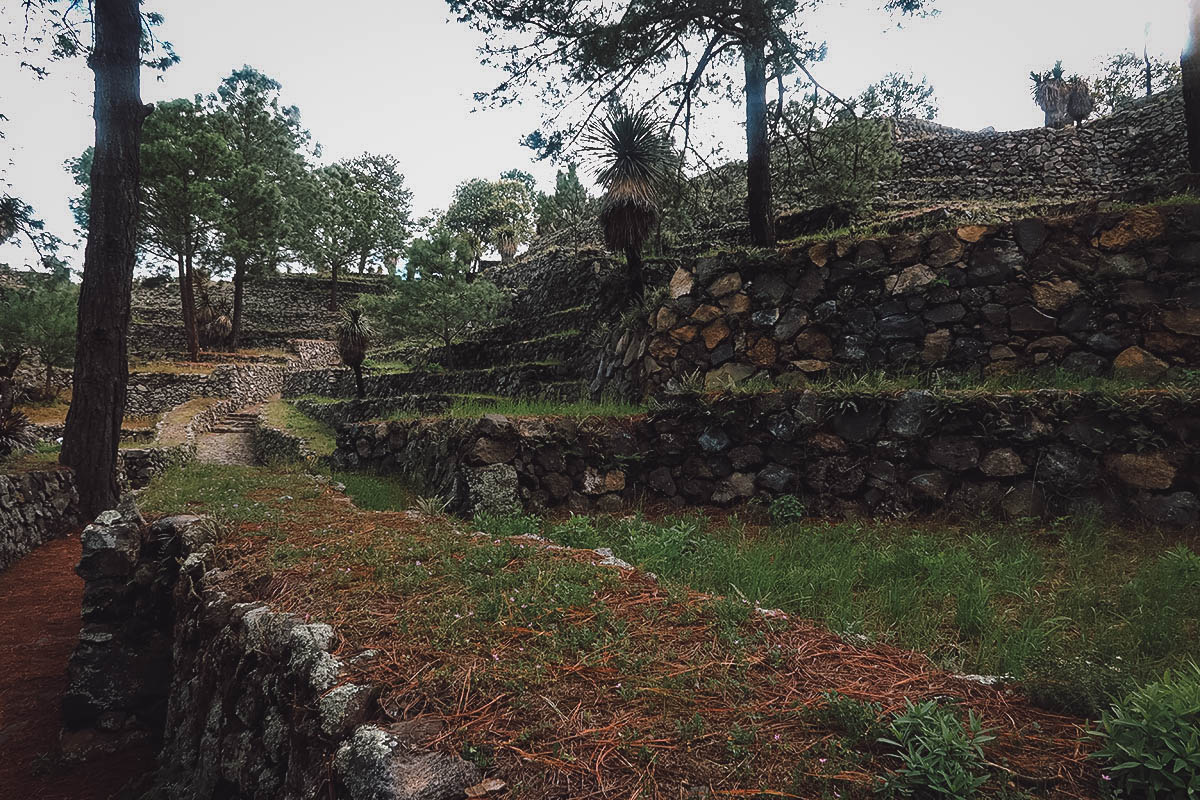
Sacrifices were made for different reasons. If I understood my guide correctly, young children offered to the gods of rain would be made to cry and scream to mimic the sound of thunder.
Human (or even animal) sacrifice is a difficult concept to grasp in modern times. I still can’t wrap my head around it. Did the ancient people consider it an honor to be sacrificed? Or were they dragged kicking and screaming to the sacrificial altar?
According to my guide, people were likely inebriated (from pulque perhaps?) before being sacrificed.
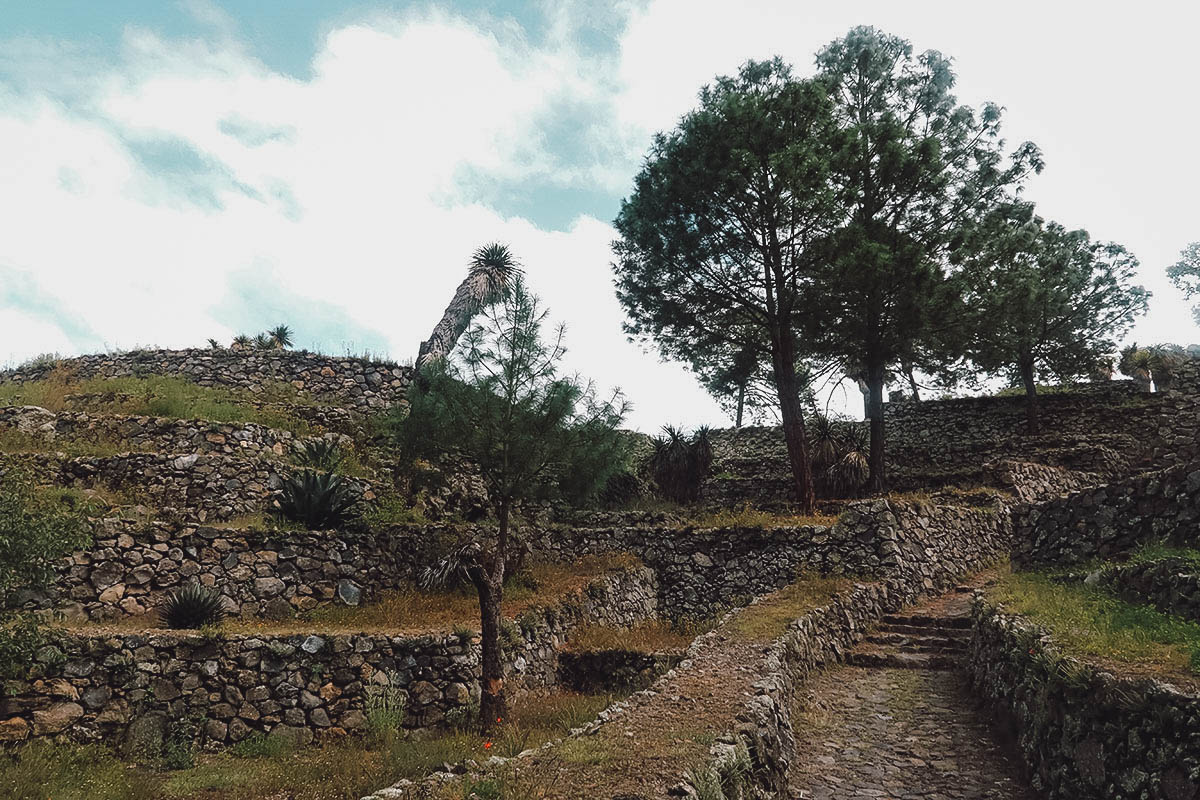
Speaking of pulque, this flowering tree was interesting. I’ve learned a lot about mezcal in Mexico but I never knew that a maguey plant left to flower would ultimately die.
What you’re looking at below is the flower of a maguey plant. Notice the dead maguey at the bottom? If left unchecked, all maguey will produce flowers and die like this. If you want it to grow to a mezcal-producing age, then you need to trim away the flowers.
My guide told me that maguey flowers are delicious and considered a delicacy in Mexico.
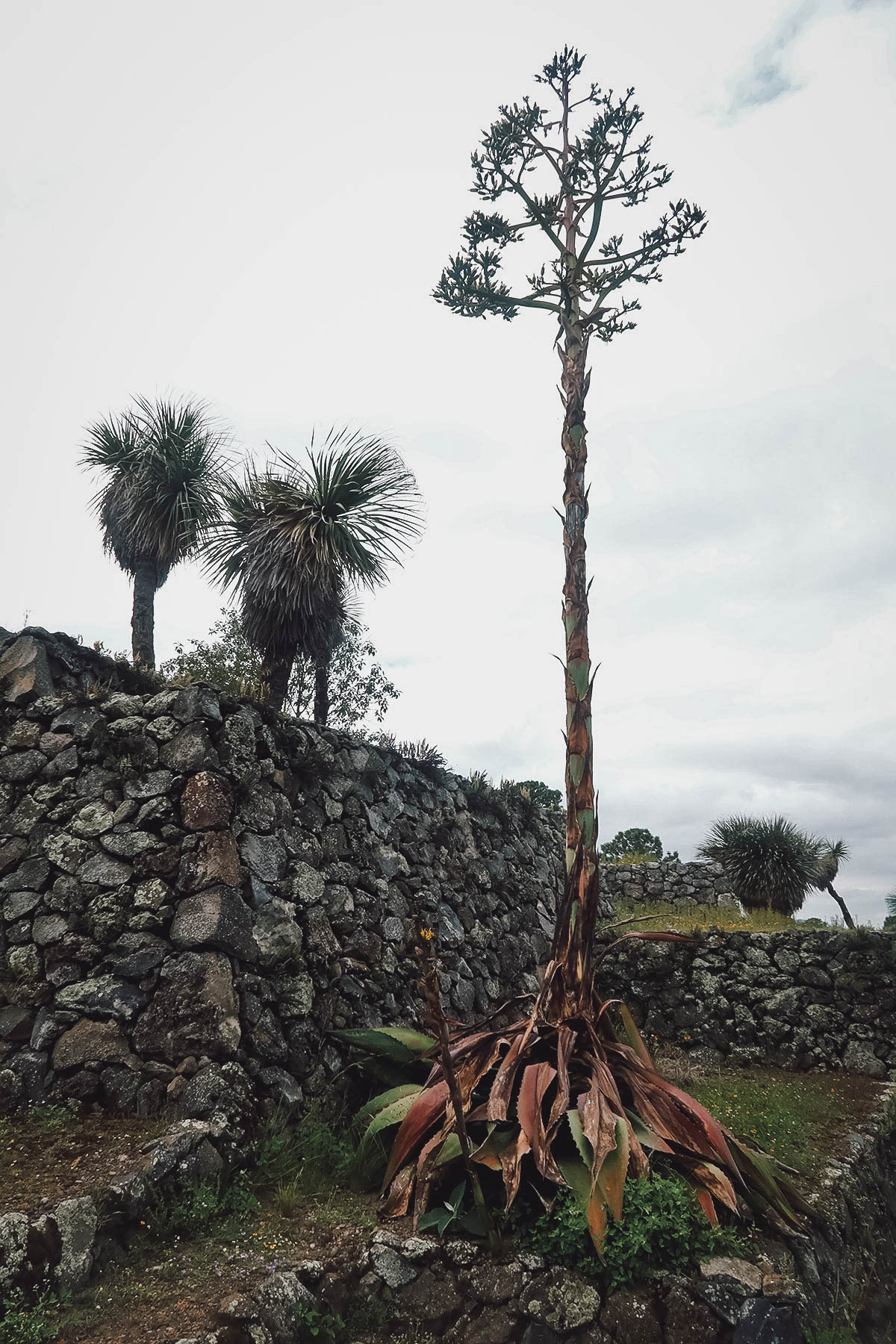
I was excited to take pictures from the tops of the pyramids in Teotihuacán only to find them cordoned off. Apparently, the climbing of pyramids in Mexico will be completely forbidden in the next year or so. This is to help with their preservation, which I completely understand.
Many of the pyramids at Cantona are already cordoned off but you can still climb a few. The views from the top are spectacular and give you a better sense of just how big this city was.
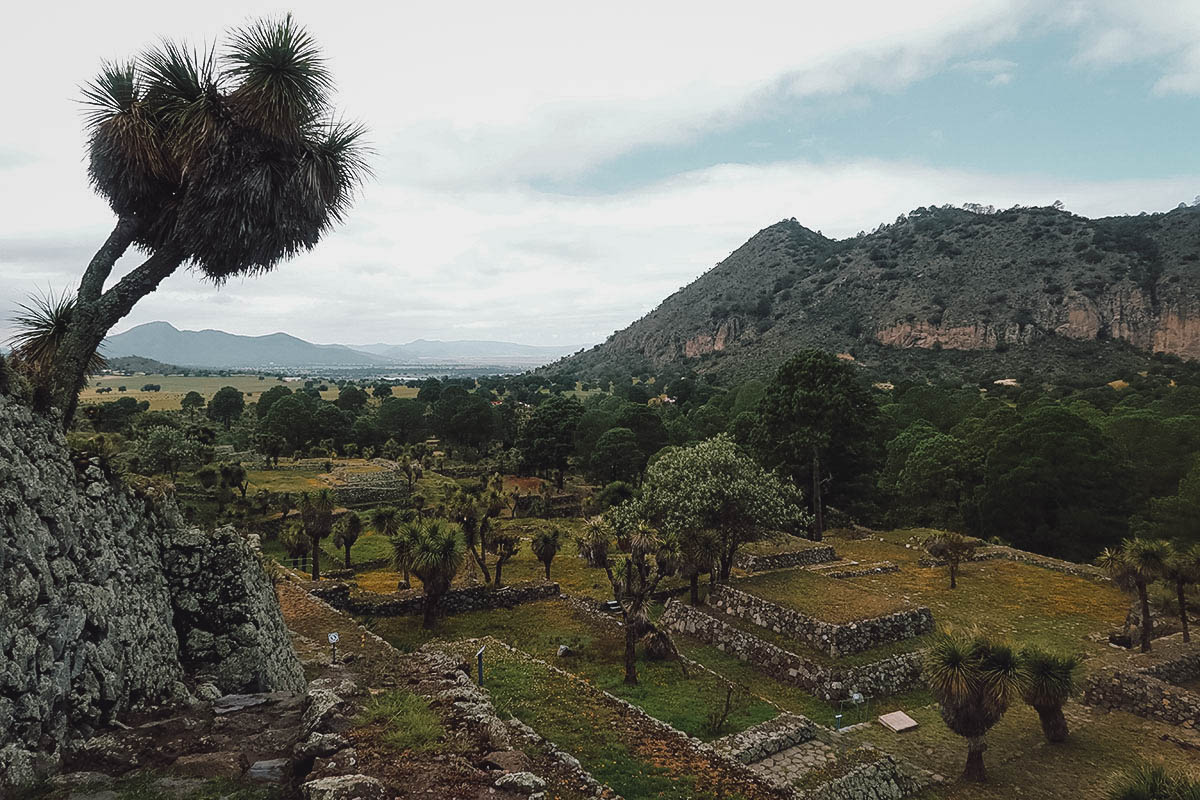
If I remember correctly, I was standing on a pyramid located in the heart of the acropolis. The acropolis is the heart of the city and home to its most important temples and ceremonial buildings.
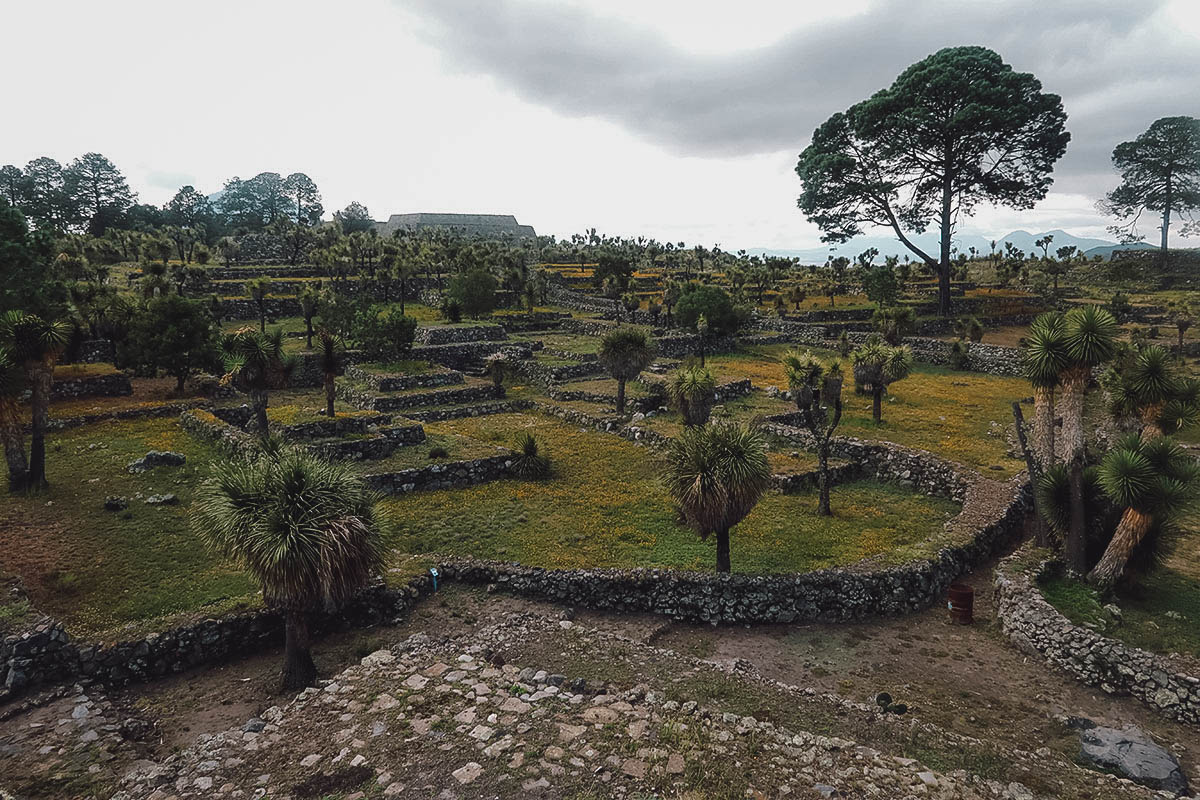
I don’t remember if this stone platform served as the base of a building or a sacrificial altar. Considering where it is, it may be the latter.
According to my guide, sacrifices were a public display and witnessed by many people. If I understood him correctly, it was something that people actually wanted to see.
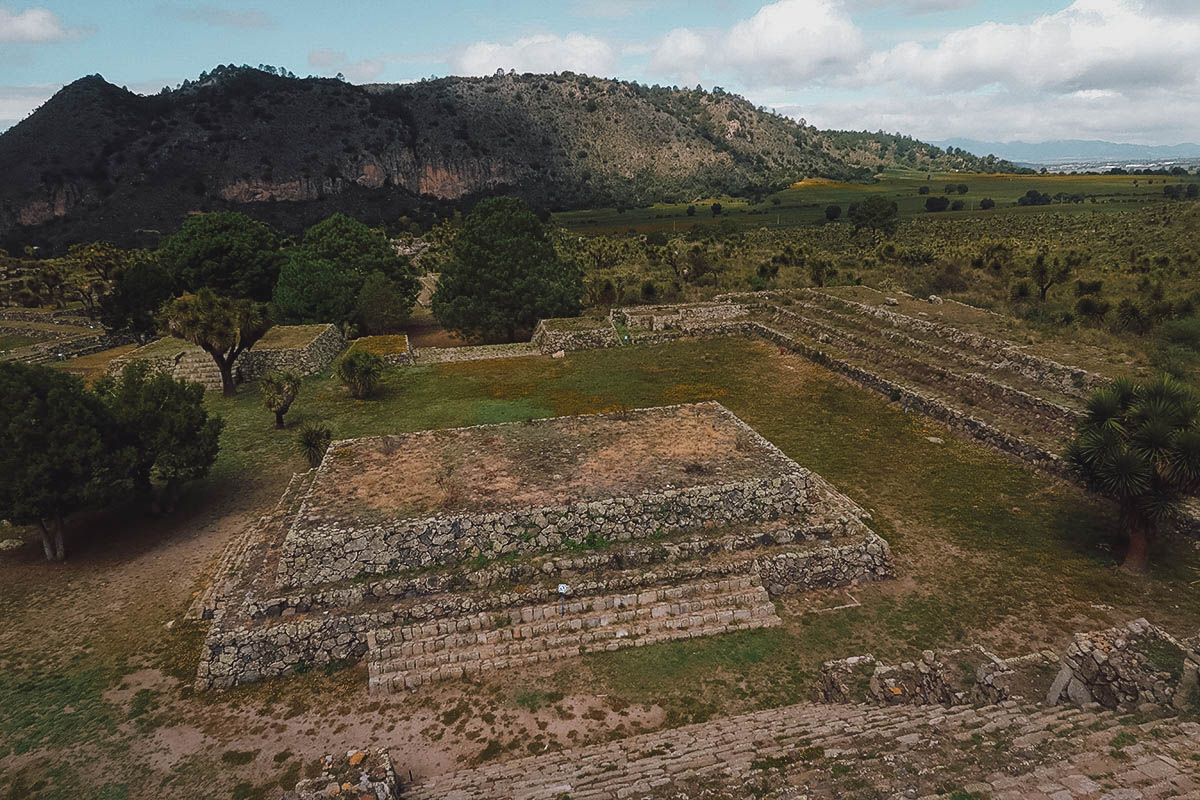
Breathtaking isn’t it? Aside from its remarkable state of preservation, what makes Cantona even more special is the fact that it’s still undiscovered.
Unlike Teotihuacán or Chichen Itza which are always flooded with tourists, Cantona gets relatively few visitors. I was here on a Tuesday and I had the entire place – all 4.6 square miles of it – to myself. Aside from the groundskeepers, there was no one else here but me and my guide.
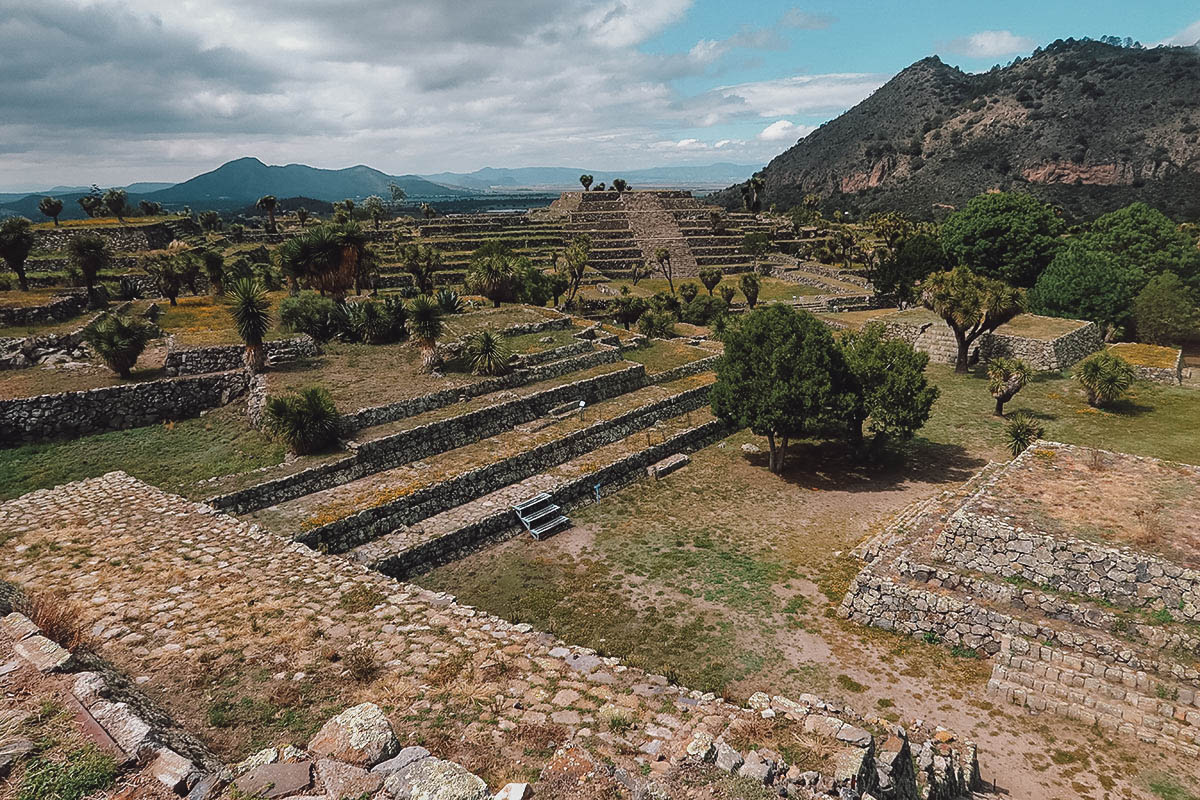
RELATED ARTICLE: Discover 20 Awesome Things to Do in Puebla, Mexico
Ball Courts
These ancient ball courts are among the most fascinating features at these Mexican ruins.
I’m still not entirely clear on the rules of the game but it basically involves two teams trying to shoot a ball – made of tree sap or resin I believe – through two rings on either side of the court. What makes the game even harder to visualize is that the men would shoot the balls through the rings using only their hips. How is that even possible?
As unclear as I am on the rules, what makes this game even more mysterious to me is that it’s played to determine who gets sacrificed. It’s unclear whether the winners or losers get sacrificed, which only furthers my confusion on how sacrifices were perceived at the time.
If the teams play to win and the winners get sacrificed, did people back then have any fear of death? Or did they give themselves up willingly because it was perceived as a noble act, one that would promise a grander afterlife?
I asked my guide these very questions but he didn’t know.
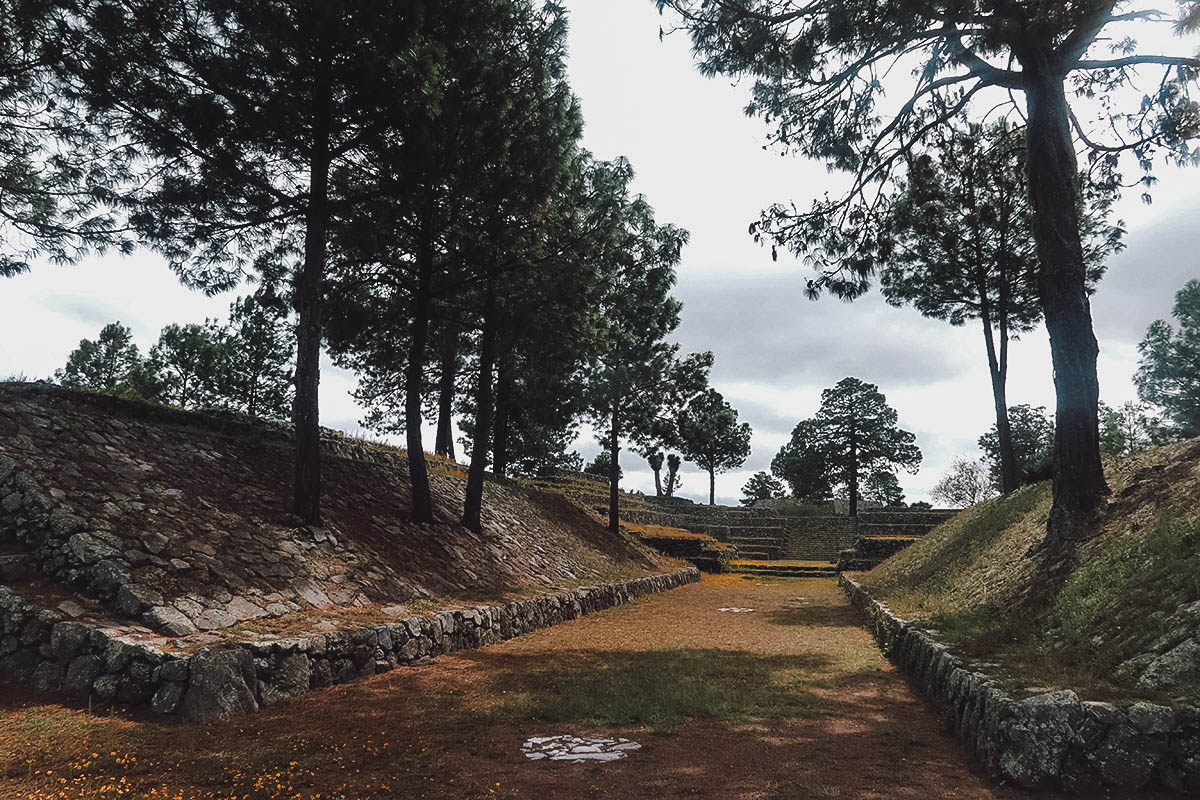
Earth Fertility Plaza
What you’re looking at below is the earth fertility plaza, one of the most prominent and impressive structures at Cantona. Apparently, the front of the pyramid is supposed to resemble the opening of a pair of legs but I don’t see it.
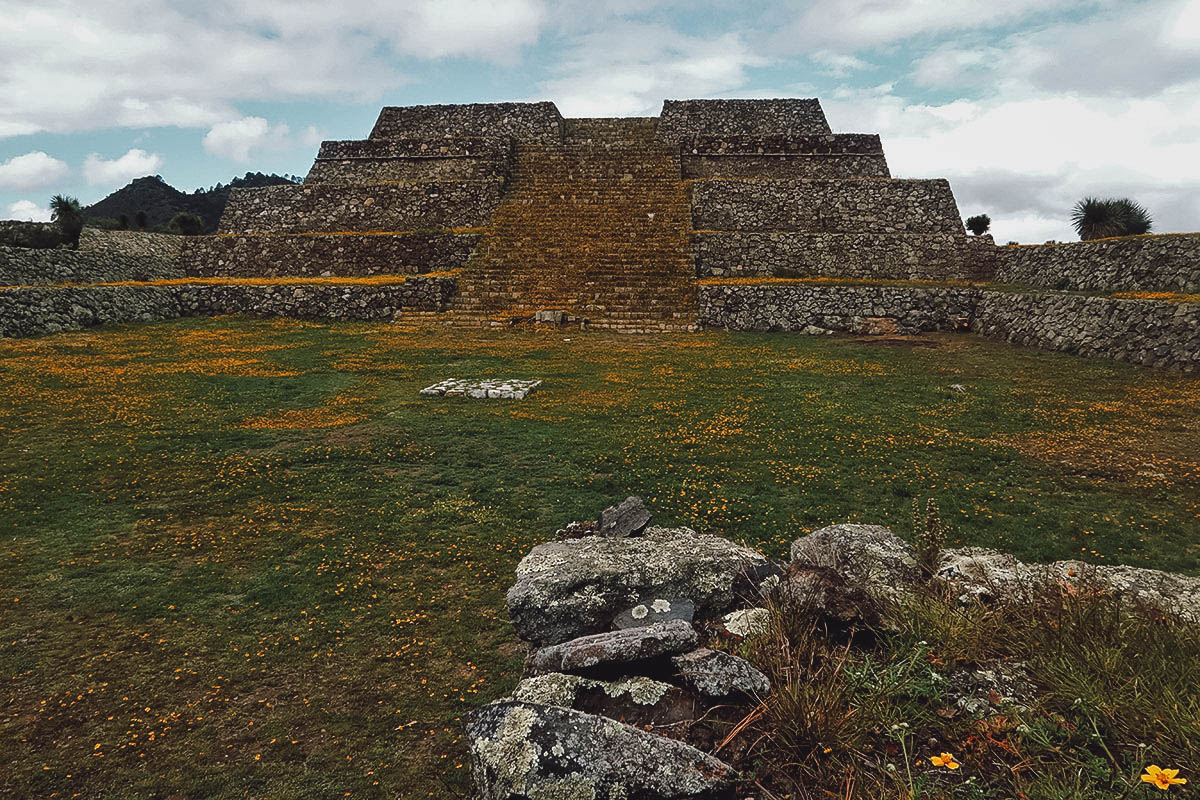
Luckily for us, this pyramid was still open to tourists so my guide and I climbed up to the top. Walk slow and resist the urge to run. This isn’t Rocky.
Because Cantona wasn’t built with any cement mortar, some of the rocks are loose so be careful what you grab onto for balance.
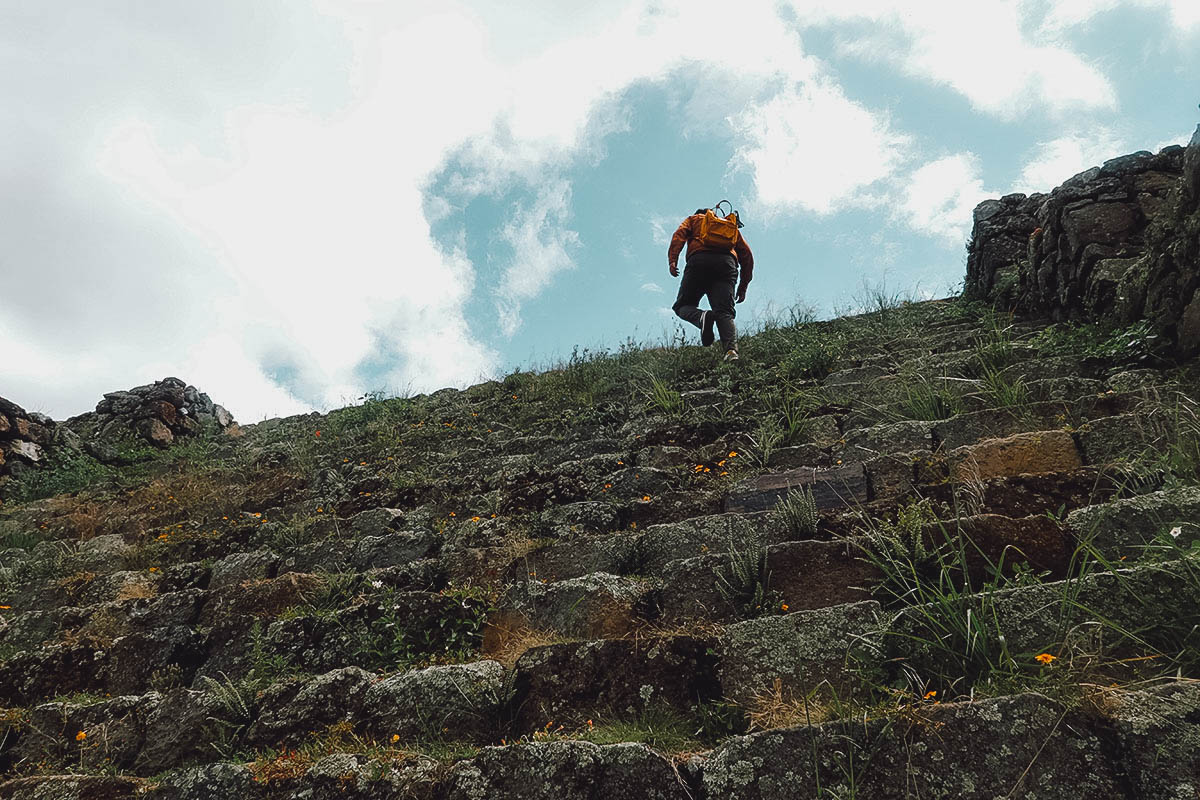
As much as I understand the need to limit access to these pyramids, I sincerely hope you get to climb to the top of this one because it offers the most spectacular views of Cantona. You’ll have unobstructed views of the entire valley with the Pico de Orizaba volcano in the distance.
As impressive as Cantona’s size already is, it isn’t even half of it. Based on estimates, what’s been excavated and restored represents just 1-10% of the city’s full size. Cantona was built on a Pleistocene basaltic outcrop (aka lava flow) so it’s easy to see from up here exactly how far the city goes.
Sadly, due to corruption and a lack of funding, there’s no excavation work being done right now so the vast majority of Cantona is still under earth and grass.
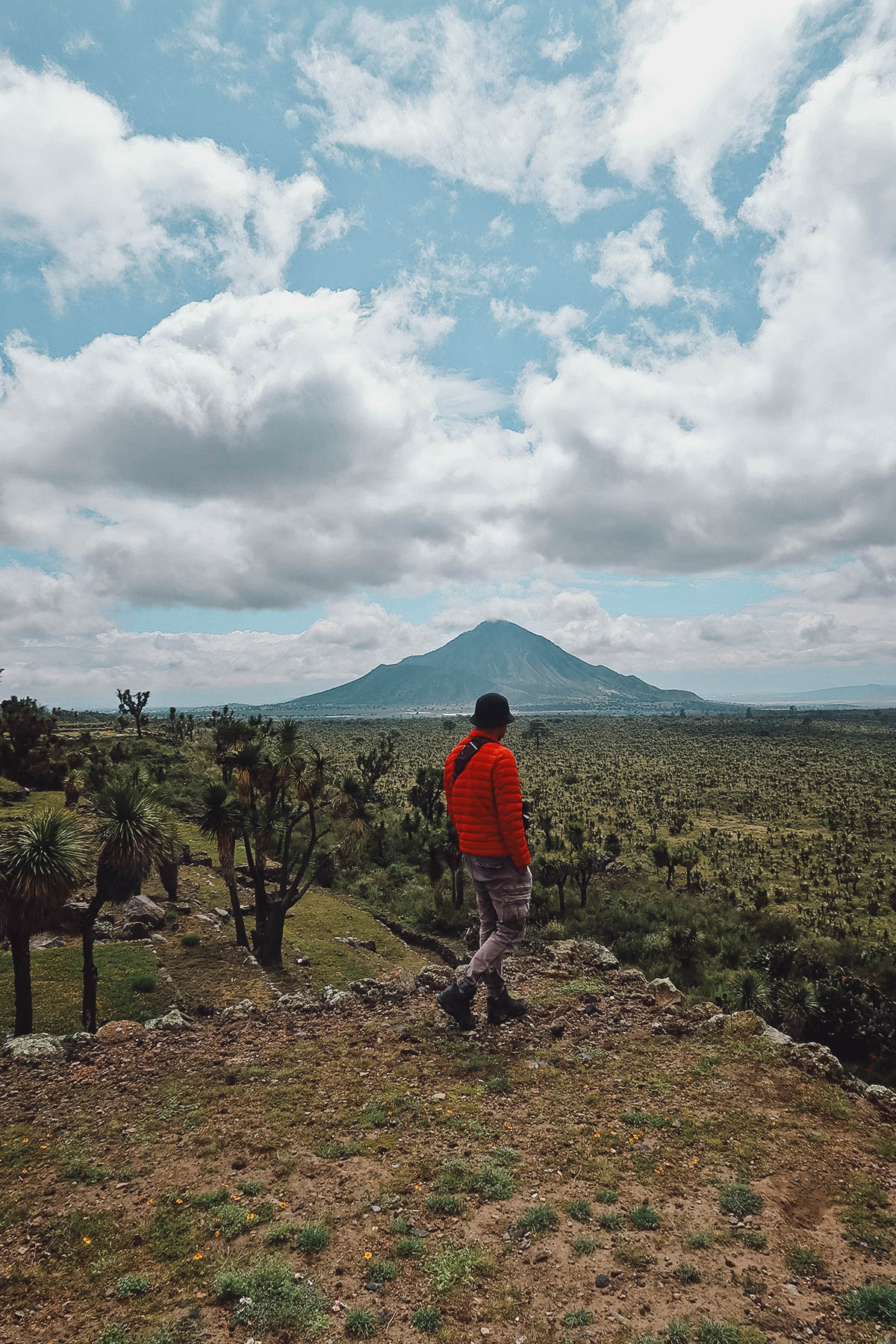
CANTONA ARCHAEOLOGICAL MUSEUM
You can visit the Cantona Museum before or after exploring the ruins but I suggest going before. Seeing all the tools and everyday objects that people used will give you a better sense of what life at Cantona was like.

The museum isn’t large but it’s interesting, especially if you have a guide explaining everything to you. On display are ceramics, carved stones, human bones, obsidian tools, statues, and other relics.
According to my guide, the presence of seashells like the large one pictured below indicated that Cantona was an affluent city that could afford to trade for such items. The Gulf of Mexico coast is over 90 miles (145 km) away.
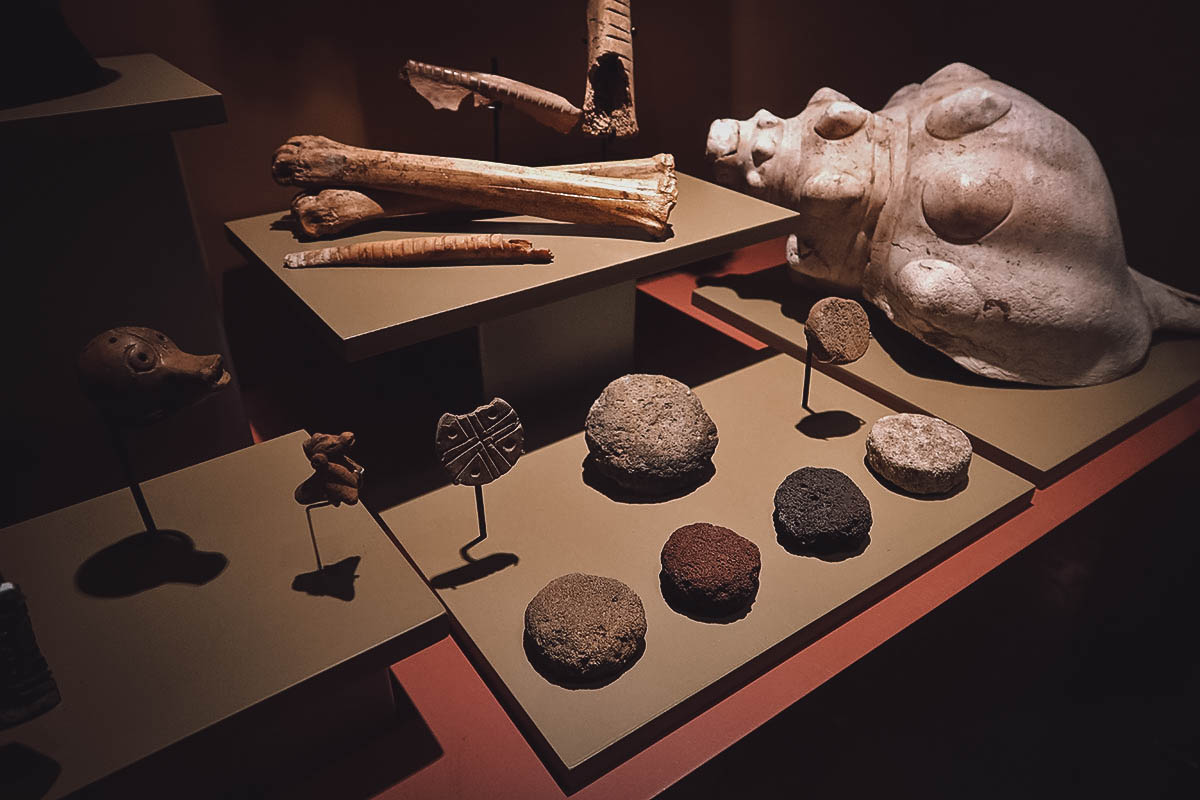
I don’t remember the god’s name but this was one of the many deity sculptures on display at the museum.
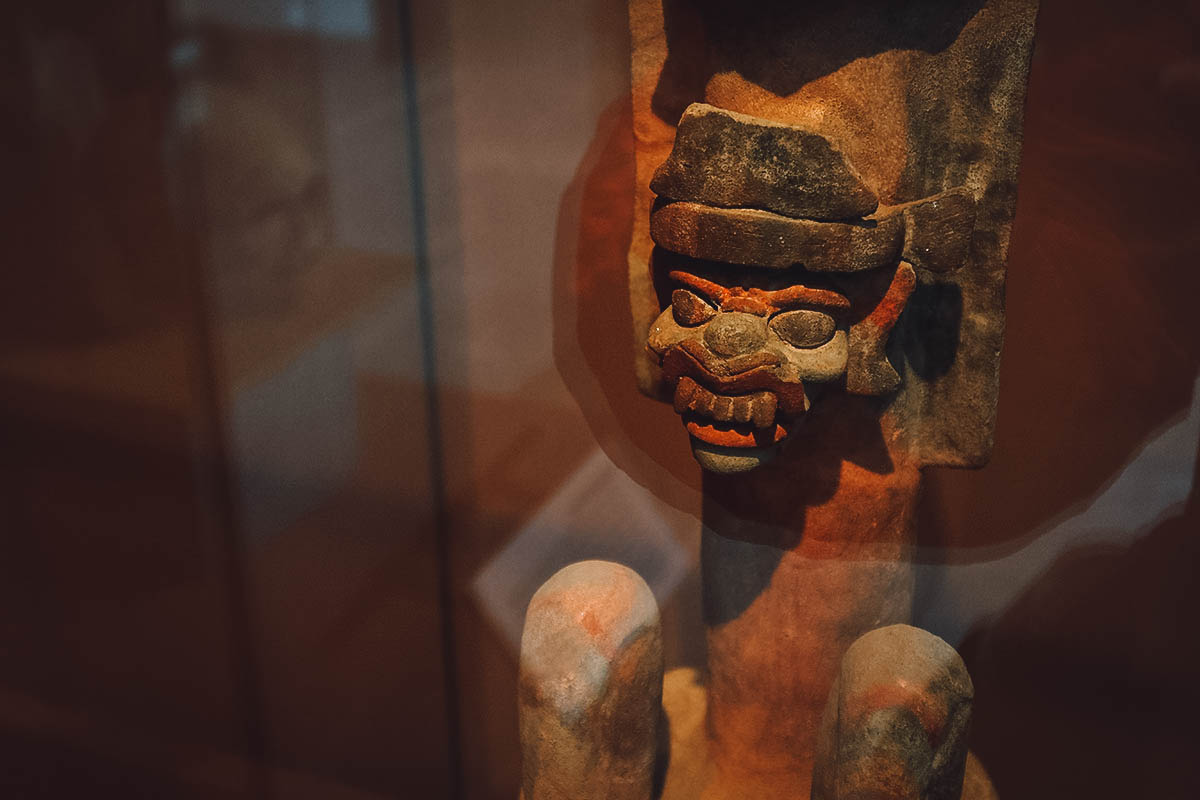
Much like Teotihuacán, Cantona owed much of its success to the large deposits of obsidian that could be mined from the nearby Oyameles-Zaragoza mountains.
Obsidian is a type of volcanic rock or glass that could be fashioned into tools or weapons for hunting. At the time, it was a valuable commodity that could be traded for other goods.

This is the biggest reason why I think it’s best to visit the museum first before exploring the site, to see this house. Note the stone base.
As you’ve seen from the many pictures in this article, these stone platforms can be found all over the site. This is how they would have looked with wooden houses built on top of them.
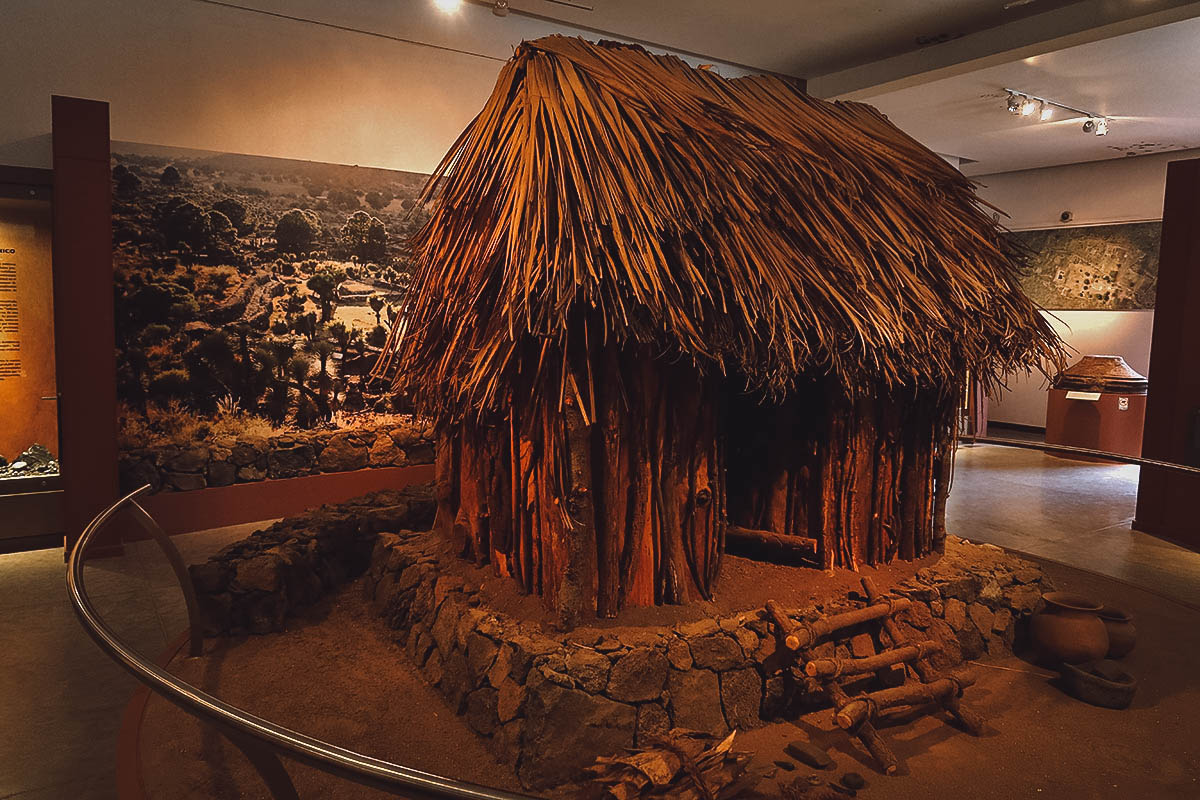
The wooden house was interesting but this pair of skulls was the most fascinating exhibit at the museum. They look similar now but wait until you see them from the side.
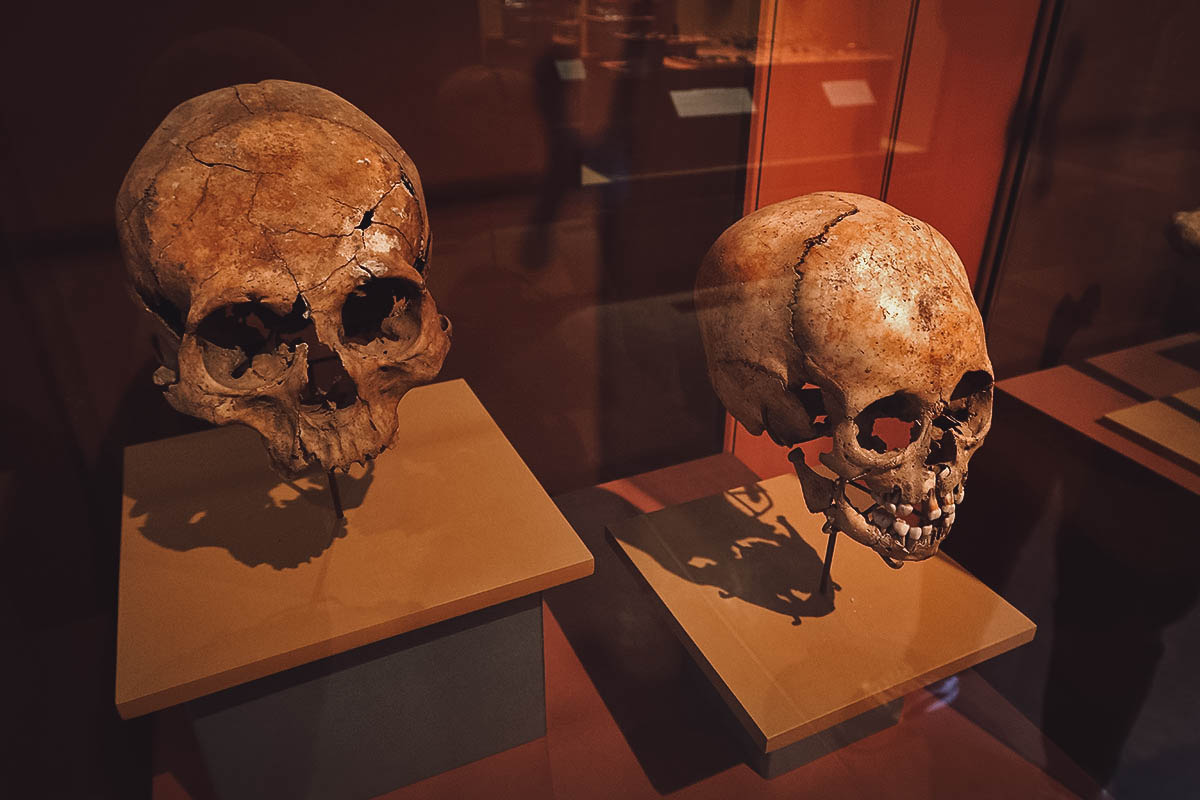
Much like today, having certain physical characteristics during that time meant that you could achieve a higher status in life. To give their children a better future, parents would sometimes compress their skulls as infants to give them a slightly different shape.
This is a fully grown skull so it’s obvious that children survived the procedure into adulthood.
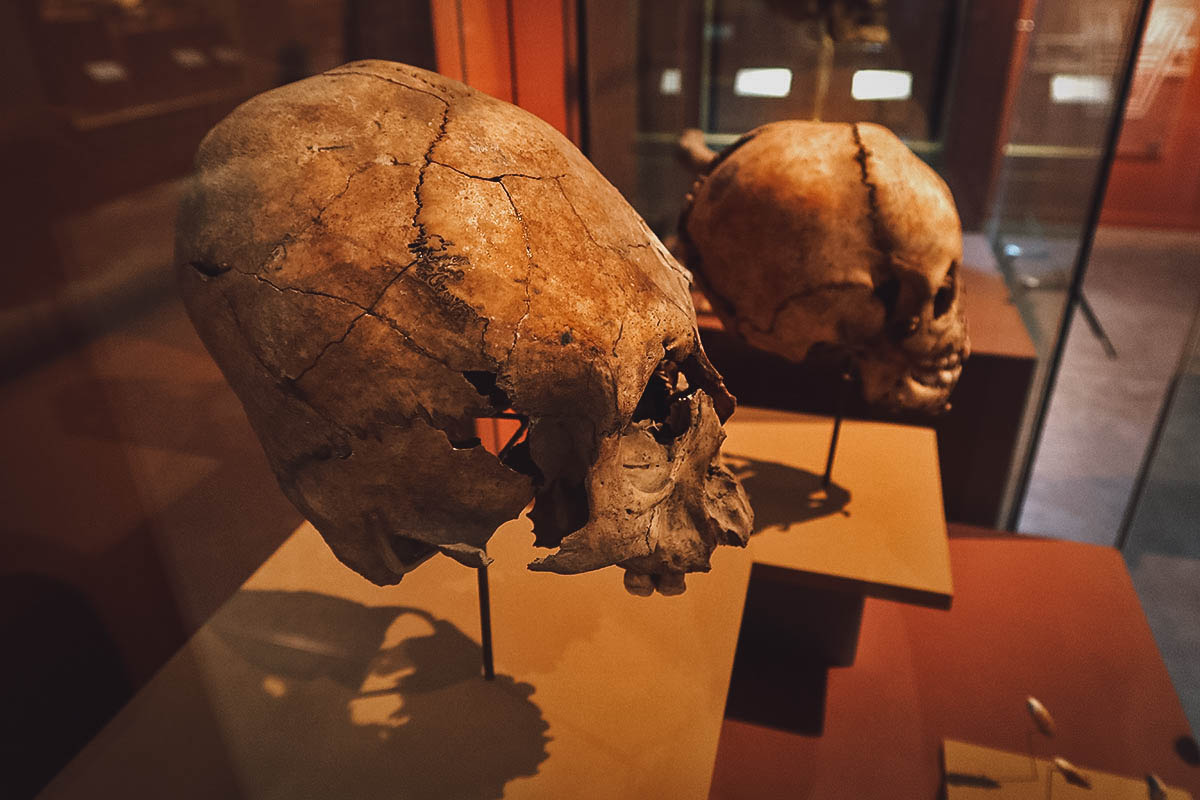
FINAL THOUGHTS ON THE CANTONA ARCHAEOLOGICAL RUINS
As described, I went on this private tour of the Cantona archaeological ruins.
After the ruins, my guide took me to nearby Laguna de Alchichica, a fascinating saltwater lagoon in an extinct volcano crater. Even if you drive to Cantona yourself, I suggest making a stop at Alchichica as well. It’s a unique and mysterious lagoon that’s probably unlike anything you’ve ever seen.
I’ve been to a few of these archaeological ruins in Mexico and Central America and Cantona is my favorite so far. It isn’t as initially impactful as Teotihuacán or as beautiful as Chichen Itza but it’s the most interesting.
If you’re spending enough time in Puebla and have an interest in archaeology, then you need to spend a day at Cantona.

Disclosure
Get Your Guide sponsored my Cantona tour in exchange for an honest account of the experience. As always, all thoughts and opinions expressed in this article on the Cantona archaeological ruins in Puebla, Mexico are mine and mine alone.
Some of the links in this article are affiliate links, meaning we’ll earn a small commission if you make a purchase at no additional cost to you. Authenticity is important to us so we only recommend products and services that we use ourselves. We really appreciate your support as it helps us keep this free Puebla travel website going. Thank you!


